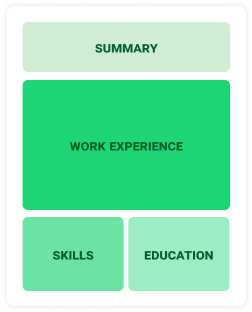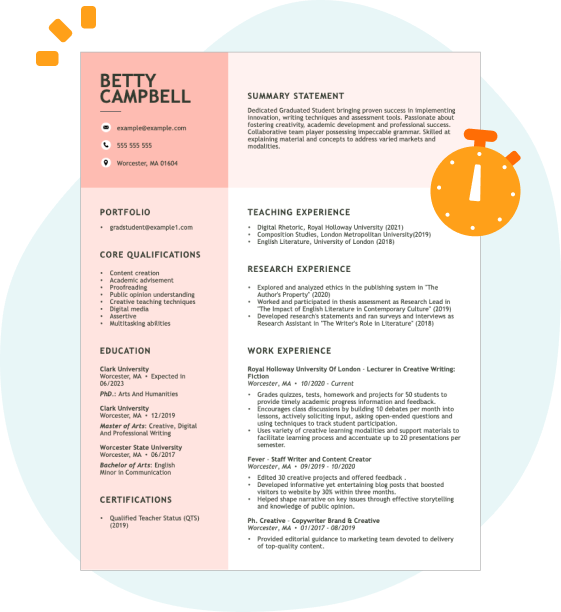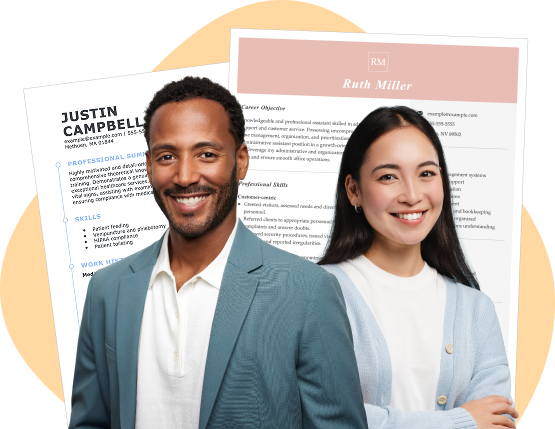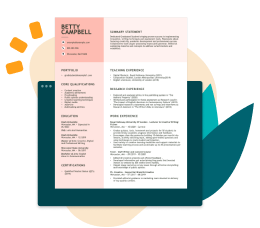For a textile engineer, hard skills include expertise in fabric technology, textile machinery operation, and quality control processes to maintain superior production standards.
Popular Textile Engineer Resume Examples
Check out our top textile engineer resume examples that emphasize key skills such as fabric technology, process optimization, and innovative design solutions. These examples will help you effectively showcase your expertise to potential employers.
Ready to build your impressive resume? Our Resume Builder offers user-friendly templates specifically designed for engineering professionals, making the process smooth and efficient.
Entry-level textile engineer resume
This entry-level resume for a textile engineer effectively showcases the applicant's accomplishments in sustainable fabric innovation and quality control improvements gained through previous roles. New professionals in this field should highlight their technical skills, educational background, and any relevant projects or certifications to attract employers despite having limited practical experience.
Mid-career textile engineer resume
This resume effectively showcases qualifications by emphasizing powerful achievements and leadership roles. The structured presentation of experiences highlights readiness for advanced responsibilities, demonstrating a strong career trajectory in textile engineering focused on innovation and sustainability.
Experienced textile engineer resume
This resume illustrates the applicant's extensive experience as a textile engineer, highlighting significant achievements such as optimizing production by 20% and implementing sustainable materials that reduced waste by 30%. The formatted bullet points improve readability, making it easy for employers to grasp key accomplishments quickly.
Resume Template—Easy to Copy & Paste
Daniel Liu
Brookfield, WI 53016
(555)555-5555
Daniel.Liu@example.com
Skills
- Textile Manufacturing
- Sustainability Practices
- Quality Control
- Supply Chain Management
- Process Optimization
- Weaving Techniques
- Production Efficiency
- Eco-friendly Materials
Languages
- Spanish - Beginner (A1)
- French - Intermediate (B1)
- Italian - Beginner (A1)
Professional Summary
Textile Engineer with over nine years of experience in innovation, sustainability, and process optimization. Proven track record of enhancing production efficiency and implementing eco-friendly practices. Recognized for leadership and achieving significant industry awards.
Work History
Textile Engineer
InnovateTextiles Corp - Brookfield, WI
October 2021 - October 2025
- Led team to enhance cotton production by 20%
- Implemented sustainable practices saving K annually
- Developed new weaving techniques increasing durability 15%
Fabric Development Specialist
Sustainable Fabrics Inc - Milwaukee, WI
September 2017 - September 2021
- Optimized dye processes reducing waste by 30%
- Pioneered eco-friendly materials, boosting sales 25%
- Managed supply chain, cut costs by 100K
Textile Quality Analyst
Crafted Textiles Plus - Milwaukee, WI
October 2016 - August 2017
- Enhanced quality controls, reducing defects by 40%
- Led audits for ISO certification, achieving compliance
- Increased customer satisfaction scores by 15%
Certifications
- Certified Textile Engineer - American Textile Certification Institute
- Lean Six Sigma Green Belt - International Six Sigma Institute
Education
Master of Science Textile Engineering
University of California, Berkeley Berkeley, California
May 2016
Bachelor of Science Material Science
University of Michigan Ann Arbor, Michigan
May 2014
How to Write a Textile Engineer Resume Summary
Your resume summary is the first thing employers will see, making it important to create a compelling introduction that grabs attention. As a textile engineer, you should focus on showcasing your technical expertise and innovative problem-solving skills in this section.
Highlight your experience with materials, processes, and design principles relevant to textile engineering. Employers want to see how your background aligns with their needs and how you can contribute to their projects.
To illustrate what makes an effective summary, we’ll provide examples that demonstrate strong practices and common pitfalls. These examples will guide you in crafting a standout resume:
Weak resume summary
I am a skilled textile engineer with experience in various projects. I seek an opportunity where I can apply my knowledge and contribute to the team's success. A company that values innovation and offers good career advancement is what I'm looking for.
- Uses vague terms like 'skilled' without providing specific examples of expertise or achievements
- Emphasizes personal desires rather than showcasing the value and skills the job seeker brings to potential employers
- Lacks concrete information about past accomplishments, making it difficult for employers to gauge qualifications
Strong resume summary
Results-driven textile engineer with 7+ years of experience in fabric development and production processes. Improved fabric durability by 20% through innovative material selection and testing protocols, while reducing manufacturing costs by 15% via process optimization. Proficient in CAD software, textile testing methods, and supply chain management to deliver high-quality products that meet customer specifications.
- Starts with a clear indication of years of experience and specific expertise in fabric development
- Highlights quantifiable achievements that showcase impact on product quality and cost efficiency
- Includes relevant technical skills that demonstrate the job seeker's competency in the textile engineering field
PRO TIP
Showcasing Your Work Experience
The work experience section is the cornerstone of your resume as a textile engineer, where you’ll provide the majority of your content. Good resume templates always emphasize this area to effectively showcase your professional background.
This section should be arranged in reverse-chronological order, listing your previous positions. Use bullet points to succinctly highlight key achievements and responsibilities from each role.
To illustrate what makes a compelling work history, we’ve put together a couple of examples. These samples will help you identify effective strategies and common pitfalls.
Textile Engineer
Innovative Fabrics Inc. – Atlanta, GA
- Worked on fabric production.
- Collaborated with team members.
- Tested materials for quality.
- Assisted in project planning.
- Lacks specific details about the projects and outcomes
- Bullet points are too broad and fail to highlight unique skills
- Focuses on routine tasks instead of effective contributions
Textile Engineer
Innovative Fabrics Inc. – Charlotte, NC
March 2020 - Current
- Develop and implement sustainable textile production processes, reducing waste by 30% over two years.
- Lead a cross-functional team to design a new line of eco-friendly fabrics, achieving a 40% increase in market share.
- Conduct quality control assessments that improved product consistency by 25%, ensuring compliance with industry standards.
- Uses strong action verbs to clearly convey the applicant's contributions
- Incorporates specific metrics to quantify achievements and impact
- Highlights relevant skills and initiatives aligned with industry standards
While your resume summary and work experience are important, don't overlook the importance of other sections. Each part plays a role in presenting your skills effectively. For more detailed insights, explore our complete guide on how to write a resume.
Top Skills to Include on Your Resume
A strong skills section is important for any resume because it allows you to showcase your qualifications at a glance. This targeted approach helps employers quickly identify if you have the necessary abilities for the role.
For a textile engineer, it's important to highlight both technical skills and relevant tools. Demonstrating expertise in CAD software, knowledge of textile testing equipment, and familiarity with production machinery can effectively show your capabilities. Important soft skills include attention to detail to ensure quality control and material specifications, creative problem-solving to optimize manufacturing processes for efficiency, and clear collaboration when communicating technical requirements across design and production teams.
Additionally, soft skills like communication, problem-solving, and teamwork are essential for collaborating effectively with design teams and ensuring seamless production operations.
When selecting skills for your resume, it's important to align them with what employers expect. Many organizations use automated systems to filter applications based on these essential resume skills, so you want to ensure yours stand out.
To effectively determine which skills to highlight, review job postings closely. They often provide valuable insights into the specific qualifications recruiters are seeking, helping your resume appeal to both hiring managers and ATS systems alike.
PRO TIP
10 skills that appear on successful textile engineer resumes
Highlighting essential skills relevant to textile engineering can significantly improve your resume, drawing the attention of potential employers. You can find these and other key qualifications showcased in our resume examples, ensuring you present yourself with confidence when applying for positions.
Here are 10 skills you should consider including in your resume if they match your background and job expectations:
Textile technology expertise
Fabric analysis
Sustainability practices
Project management
Attention to detail
Problem-solving abilities
Team collaboration
Quality control methods
Skill in CAD software
Research and development skills
Based on analysis of 5,000+ industrial engineering professional resumes from 2023-2024
Resume Format Examples
Selecting the appropriate resume format is important for textile engineers as it emphasizes relevant skills, experiences, and career advancements that align with industry expectations.
Functional
Focuses on skills rather than previous jobs

Best for:
Best for recent graduates and career changers with up to two years of experience
Combination
Balances skills and work history equally

Best for:
Mid-career engineer focused on showing their skills and pursuing growth opportunities
Chronological
Emphasizes work history in reverse order

Best for:
Experts leading innovative textile solutions and sustainable practices
Frequently Asked Questions
Should I include a cover letter with my textile engineer resume?
Absolutely, including a cover letter is important for showcasing your unique qualifications and passion for the textile engineering role. It allows you to highlight relevant experiences and connect personally with potential employers. If you're looking for help crafting yours, explore our resources on how to write a cover letter or use our Cover Letter Generator to create a standout letter quickly.
Can I use a resume if I’m applying internationally, or do I need a CV?
For international job applications, use a CV when the employer requests it or when applying in regions where CVs are standard. Explore our CV examples to understand effective formatting and review tips on how to write a CV that aligns with global expectations.
What soft skills are important for textile engineers?
Soft skills such as communication, problem-solving, and teamwork are essential for textile engineers. These interpersonal skills foster collaboration with colleagues and clients, ensuring effective project execution and innovation in design, which ultimately leads to successful outcomes in the textile industry.
I’m transitioning from another field. How should I highlight my experience?
When applying for textile engineer positions, highlight your transferable skills like creativity, project management, and analytical thinking. These abilities illustrate your potential contribution to product development and innovation in the textile industry. By using concrete examples from previous roles, you can effectively show how you've successfully tackled challenges that align with engineering responsibilities.
How should I format a cover letter for a textile engineer job?
To format a cover letter for textile engineer positions, start by including your contact information. Then, add a professional greeting and an engaging opening paragraph that shows your interest in the role. Provide a clear summary of your qualifications and experiences that relate to the job description. Finish with a strong call to action to encourage further discussion about your candidacy.
Should I include a personal mission statement on my textile engineer resume?
Yes, including a personal mission statement on your resume is advisable. It showcases your values and career aspirations, making it particularly effective when applying to organizations that prioritize innovation and sustainability in their culture or objectives.







